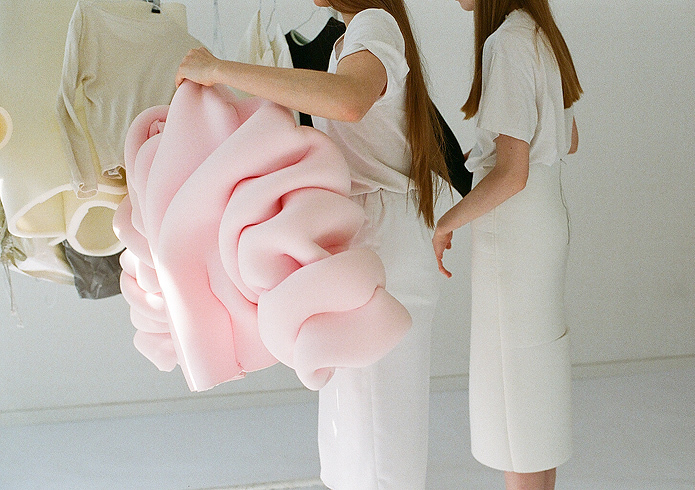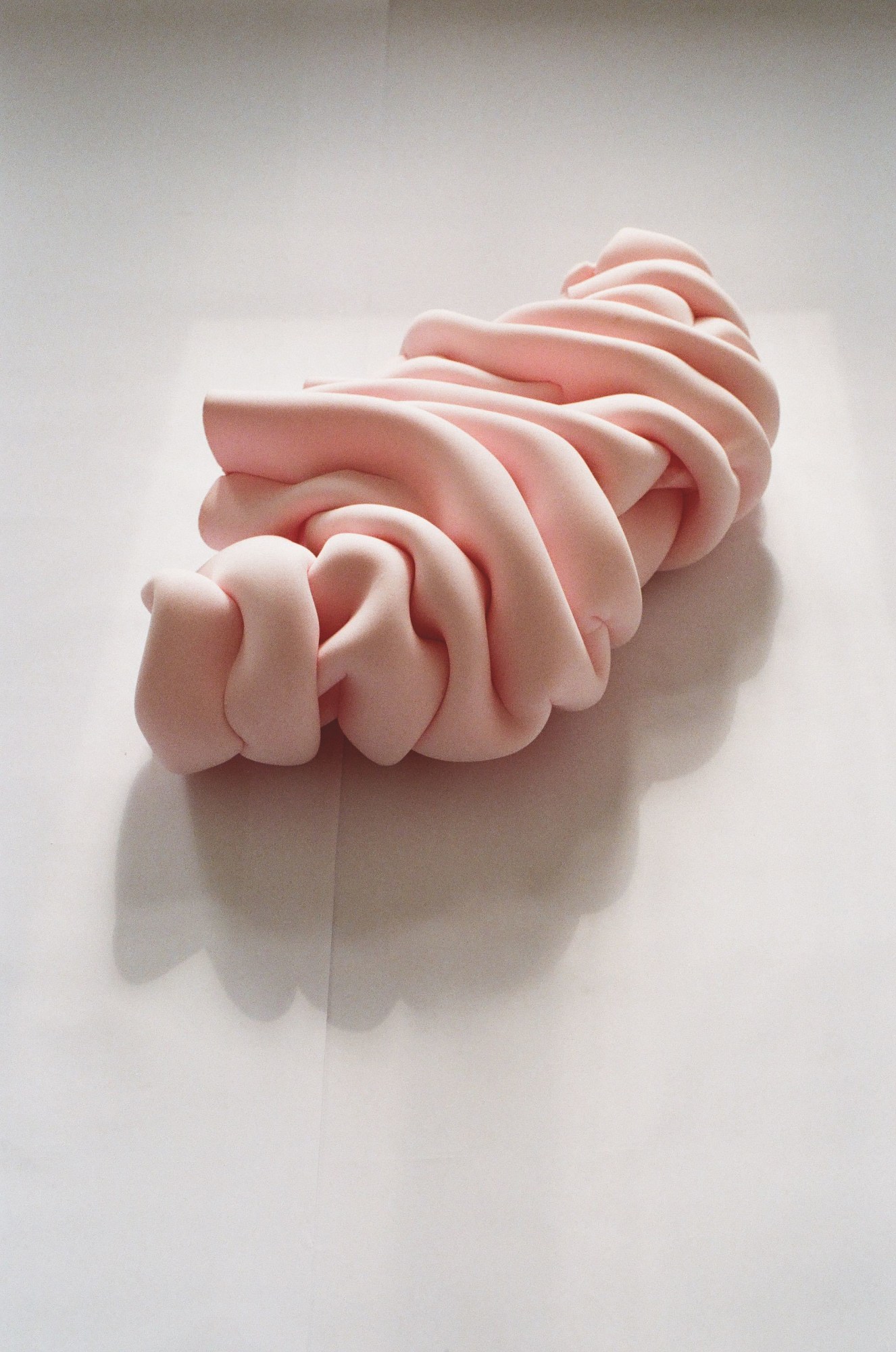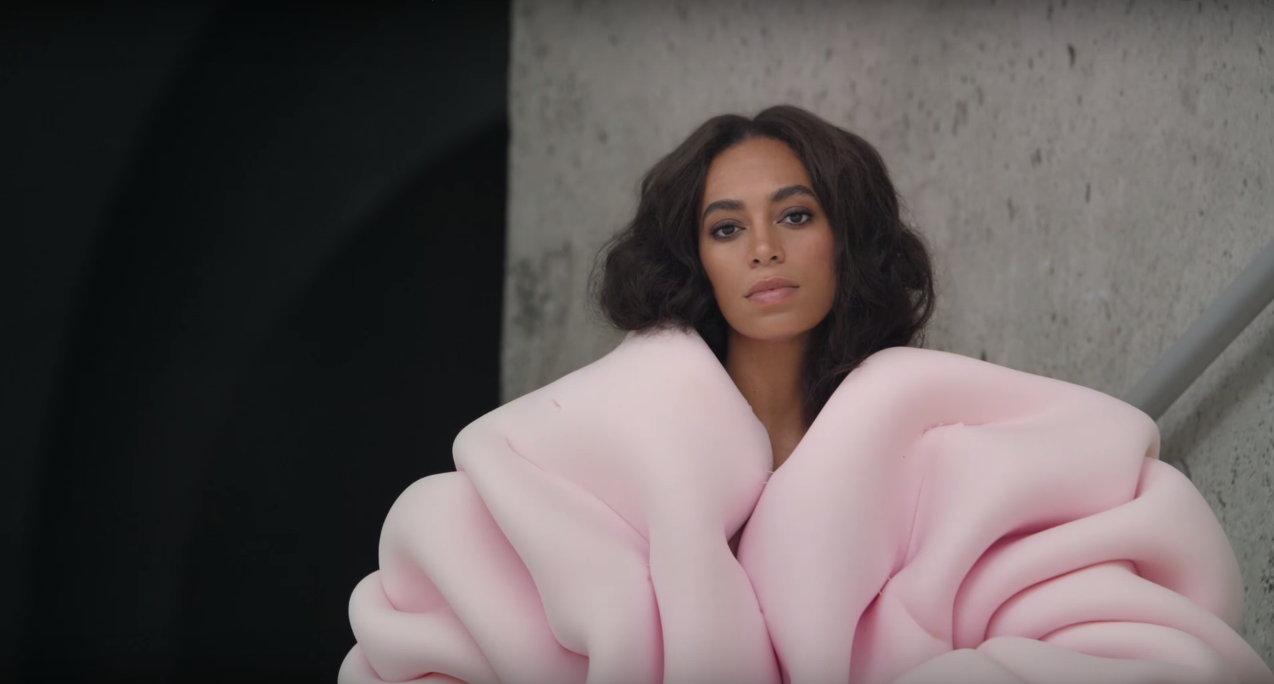In the very important video for “Cranes in the Sky” that she released earlier this week, Solange Knowles wears a piece of clothing that looks more like a piece of furniture. It’s a powder-pink eruption of a sweater that somehow evokes both the architectural wobble of an Ettore Sottsass mirror and the pleasing textural squash of marshmallows. The sweater, in which Solange sits on a concrete stair wearing little else but nail polish, is the video’s visual centerpiece; it fills half the screen when you pull up the track on YouTube. And its radical softness feels entirely in keeping with Solange’s message at large.
The piece was made by 30-year-old German textile designer Nadine Goepfert as part of her collection The Garments May Vary, a selection of clothes made from materials that record the movements of their wearers. It weighs, she says, “four or five kilos” (around 10 pounds).

Since graduating from the Gerrit Rietveld Academie in Amsterdam in 2013 (after also studying textile design in Berlin), Goepfert has collaborated with choreographers, furniture studios, architects, carpet weavers, and floral designers, as well as pursuing her own experimental projects. She’s made sweaters from copper wire, exhibited latex artworks, and dreamed up Tibetan wool rugs that look like beautiful colonies of rainbow-colored microorganisms.
Over the phone from her studio in Berlin, Nadine spoke to i-D about what it means to design sweaters that are also art.
How did this particular piece end up in “Cranes in the Sky”?
Earlier this year, I got a call from Shiona Turini, Solange’s stylist, asking if I could lend them a piece for the Met Ball. Of course, I felt so honored that Solange would want to wear my piece for this occasion. Though usually, this piece, and almost all of my work, is shown in the context of exhibitions at museums and galleries. The memory foam sweater is actually super heavy. It looks amazing when it’s worn but certainly it’s not comfortable at all! It’s more of a conceptual piece. So I talked about this with Shiona and she said that’s part of the reason she loves it so much. We ultimately decided we’d find another occasion to collaborate, at the right moment. In August, Shiona emailed me again and said that Solange really liked the idea of wearing this garment in the visuals for her new album. So I sent it over! I never really knew what was going to happen with it, so I was very surprised.
What ideas does the piece represent for you?
I designed it in 2013. It’s part of my collection Garments May Vary, which emerged against a backdrop of the subject of conservation — the idea of capturing a certain moment of movement. So the garments change form, structure, color, through ordinary usage. I was investigating the daily usage of garments, and the associations of the person that is wearing it. Each of the materials highlights a different form and change, they seek to temporarily or permanently capture the traces of movement of the wearer.

Tell me more about memory foam… How easy or hard is it to turn it into something wearable?
Usually you buy it for mattresses! But I really had this picture in mind of this sweater that I wanted to make. For me, it wasn’t white, it had a color. But you can’t paint foam — it would totally lose its characteristics — so I was searching for a really, really long time for this material in a color. I really wanted to have it in pink, and it took a while to find it! I only finished it like three days before the shoot, because the material arrived super late! And then suddenly it was there, and I was like, “What did I create?!”
What does it mean to see it in such a different context, in a music video?
Usually, I like it to be shown in a museum or gallery, because then people start to get interested in the idea behind the piece — what it is about, and if there is more to know about this garment beyond its aesthetic. But I think that the way that Solange wears it in the video, and the whole video, is artistic. It’s not like a pop video. There is a message. Everything that she’s wearing is a special piece. I like that she was mostly working with young designers, or not well known designers, and combining those piece with things she’d made. Sometimes, if you lend your things to stylists, you never know what they’re going to do with it. But I trusted them from the first moment and knew that I would like what they did.
Did you think about going into fashion design in a more traditional sense, or did you always want to do your own thing?
I really wanted to try and do my own thing. I studied textile design in Berlin and Amsterdam and graduated in 2013. Already, during my studies, I had started to work freelance with other studios and I had so many ideas, so I really wanted to have time to build up my own studio. Now, I work in fashion and interiors, and many other different fields. I like that about textile design — that you don’t have to stick to one product. It’s not always a garment that comes out in the end.
What are you working on right now?
There will be a new collection coming out in around two weeks. In my earlier collections Matters of Habit and Breaks in Continuity the pieces deal with the relationship between garment and person. The new collection deals with the relationship between garment and object. I’m also working on a carpet design.
What are some of the least traditional materials you’ve ever worked with?
I’m always into the combination of natural materials and synthetic stuff, like foam and latex. I also used wire in the last collection. I knitted a sweater from copper wire. It captures moments and the body language of the person. For example, if you roll back the sleeves, they stay in that shape.
Do you have any dream future collaborations?
There is no particular person I’m thinking about. But in general I like to work with like-minded creatives from all fields that share a similar creative approach to mine, as I think Solange (as well as Carlota [Guerrero], Alan [Ferguson], and the rest of her team) does.
Related: Meet Carlota Guerrero, the photographer responsible for Solange’s new album imagery
Credits
Text Alice Newell-Hanson
Nadine Goepfert collection imagery Sanna Helena Berge
